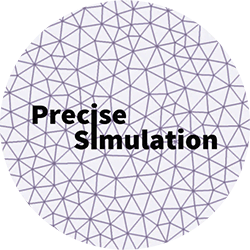
|
FEATool Multiphysics
v1.17.5
Finite Element Analysis Toolbox
|

|
FEATool Multiphysics
v1.17.5
Finite Element Analysis Toolbox
|
EX_LAPLACE1 2D Laplace equation example on a unit square.
[ FEA, OUT ] = EX_LAPLACE1( VARARGIN ) Laplace equation on a unit square with exact solution 2*y/((1+x)^2+y^2). Accepts the following property/value pairs.
Input Value/{Default} Description
-----------------------------------------------------------------------------------
igrid scalar 1/{0} Cell type (0=quadrilaterals, 1=triangles)
hmax scalar {1/10} Max grid cell size
refsol string {2*y/((1+x)^2+y^2)} Reference solution
sfun string {sflag1} Shape function
iphys scalar 0/{1} Use physics mode to define problem (=1)
or directly define fea.eqn/bdr fields (=0)
iplot scalar 0/{1} Plot solution (=1)
.
Output Value/(Size) Description
-----------------------------------------------------------------------------------
fea struct Problem definition struct
out struct Output struct
cOptDef = { ...
'igrid', 0; ...
'hmax', 0.1; ...
'refsol', '2*y/((1+x)^2+y^2)'; ...
'sfun', 'sflag1'; ...
'iphys', 1; ...
'icub', 2; ...
'iplot', 1; ...
'fid', 1 };
[got,opt] = parseopt(cOptDef,varargin{:});
fid = opt.fid;
% Geometry definition.
gobj = gobj_rectangle();
fea.geom.objects = { gobj };
% Grid generation.
if ( opt.igrid==-1 )
fea.grid = rectgrid(round(1/opt.hmax));
fea.grid = quad2tri( fea.grid );
elseif ( opt.igrid==0 )
fea.grid = rectgrid(round(1/opt.hmax));
else
fea.grid = gridgen(fea,'hmax',opt.hmax,'fid',fid);
end
n_bdr = max(fea.grid.b(3,:)); % Number of boundaries.
% Problem definition.
fea.sdim = { 'x' 'y' }; % Coordinate names.
if ( opt.iphys==1 )
fea = addphys(fea,@poisson); % Add Poisson equation physics mode.
fea.phys.poi.sfun = { opt.sfun }; % Set shape function.
fea.phys.poi.eqn.coef{3,4} = { 0 }; % Set source term coefficient to zero.
fea.phys.poi.bdr.coef{1,end} = repmat({opt.refsol},1,n_bdr); % Set Dirichlet boundary coefficient to reference solution.
fea = parsephys(fea); % Check and parse physics modes.
else
fea.dvar = { 'u' }; % Dependent variable name.
fea.sfun = { opt.sfun }; % Shape function.
% Define equation system.
fea.eqn.a.form = { [2 3;2 3] }; % First row indicates test function space (2=x-derivative + 3=y-derivative),
% second row indicates trial function space (2=x-derivative + 3=y-derivative).
fea.eqn.a.coef = { 1 }; % Coefficient used in assembling stiffness matrix.
fea.eqn.f.form = { 1 }; % Test function space to evaluate in right hand side (1=function values).
fea.eqn.f.coef = { 0 }; % Coefficient used in right hand side.
% Define boundary conditions.
fea.bdr.d = cell(1,n_bdr);
[fea.bdr.d{:}] = deal(opt.refsol); % Assign reference solution to all boundaries (Dirichlet).
fea.bdr.n = cell(1,n_bdr); % No Neumann boundaries ('fea.bdr.n' empty).
end
% Parse and solve problem.
fea = parseprob(fea); % Check and parse problem struct.
fea.sol.u = solvestat(fea,'fid',fid,'icub',opt.icub); % Call to stationary solver.
% Postprocessing.
s_err = ['abs(',opt.refsol,'-u)'];
if ( opt.iplot>0 )
figure
subplot(2,1,1)
postplot(fea,'surfexpr','u')
title('Solution u')
subplot(2,1,2)
postplot(fea,'surfexpr',s_err)
title('Error')
end
% Error checking.
if ( size(fea.grid.c,1)==4 )
xi = [0;0];
else
xi = [1/3;1/3;1/3];
end
err = evalexpr0(s_err,xi,1,1:size(fea.grid.c,2),[],fea);
ref = evalexpr0('u',xi,1,1:size(fea.grid.c,2),[],fea);
err = sqrt(sum(err.^2)/sum(ref.^2));
if( ~isempty(fid) )
fprintf(fid,'\nL2 Error: %f\n',err)
fprintf(fid,'\n\n')
end
out.err = err;
out.pass = out.err<0.01;
if ( nargout==0 )
clear fea out
end